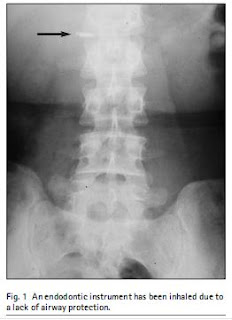RUBBER DAM
The use of a rubber dam is almost mandatory in modern endodontic practice for three reasons.
Firstly, it provides an aseptic operating field, isolating the tooth from oral and salivary contamination. It cannot be stressed enough that contamination of the root canal with saliva introduces new microorganisms to the root canal which may prolong treatment and reduce prognosis.
Secondly, rubber dam facilitates the use of the strong medicaments necessary to clean the root canal system.
Finally, it protects the patient from the inhalation or ingestion of endodontic instruments, as shown in Figure 1.
Practitioners may also be advised to develop their rubber dam skills for another reason. Research has shown
that rubber dam used during routine conservation procedures reduces aerosol contamination and cross-infection by up to 98.5%.
Research has also shown that patients do not dislike the use of rubber dam,
and the author has never had a single patient request its removal once the reasons for its use have been explained. It may be particularly helpful to explain to the patient that the rubber dam is necessary to isolate the operating area in exactly the same way as a surgical drape is essential for similar invasive medical procedures, where bacterial contamination may have a profound effect on the outcome. Indeed, refusal to accept a rubber dam may preclude the prescription of endodontic therapy. If an endodontic instrument is
inhaled, a medicolegal allegation of negligence may be impossible to defend, even if the patient had appeared to accept the risk. A practitioner should never do anything to a patient which he or she knows to be wrong, and a patient may not sign away their rights in law. With a little practice, an understanding of the basic principles, a well organised surgery and a well-trained dental nurse, a single tooth can be isolated in only a few seconds.
